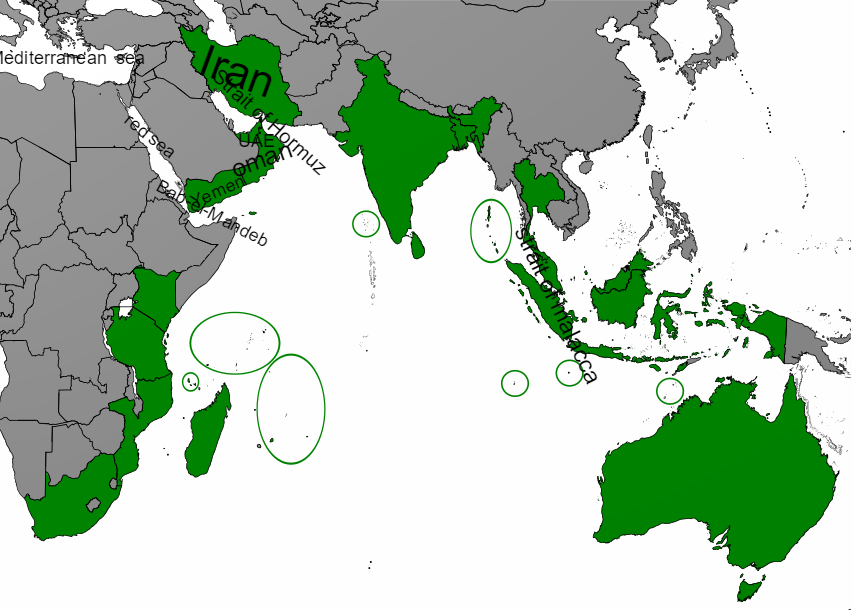This post continues from the series on International Relations for IAS Prep. Read the essential posts here –
- An IAS Aspirant’s guide to cracking International Relations
- Analysis | Previous year’s IAS Mains questions from IR
When was IORA conceived?
1997 in Ebene Cyber City, Mauritius
Origins:
- First established as Indian Ocean Rim Initiative in Mauritius on March 1995 and formally launched in 1997 by the conclusion of a multilateral treaty known as the Charter of the Indian Ocean Rim Association for Regional Cooperation.
- It is based on the principles of Open Regionalism for strengthening Economic Cooperation particularly on Trade Facilitation and Investment, Promotion as well as Social Development of the region.
Members:
20 member states (including India) and 7 dialogue partners, the Indian Ocean Tourism Organisation and the Indian Ocean Research Group has observer status. 20th member was Comoros (latest added in 2012)

Objectives:
- To promote sustainable growth and balanced development of the region and member states
- To focus on those areas of economic cooperation which provide maximum opportunities for development, shared interest and mutual benefits
- To promote liberalisation, remove impediments and lower barriers towards a freer and enhanced flow of goods, services, investment, and technology within the Indian Ocean rim
- In recent years, new and emerging issues for the better management and governance of Indian Ocean resources have begun taking shape.
- Such issues include blue economy development and sectoral integration
Six priority areas:
- Maritime safety and security
- Trade and investment facilitation
- Fisheries management
- Disaster risk management
- Academic science and technology cooperation
- Tourism and cultural exchanges
First IORA Ministerial Blue Economy Conference –
- In 2015, First IORA Ministerial Blue Economy Conference, titled as, Enhancing Blue Economy Cooperation for Sustainable Development in the IORA Region, was held in Mauritius
- Blue Economy is a new comprehensive concept, incorporating the Ocean Economy, environment and sustainability to provide basic human needs such as potable water, food, jobs and habitable shelter
- Conference aims to act as an ideal platform to bring together Member States and Dialogue Partners of the IORA to promote Blue Economy in the Indian Ocean region
Conference focused on 4 priority areas namely :
- Fisheries & Aquaculture
- Renewable Ocean Energy
- Seaports & Shipping
- Seabed Exploration & Minerals
China’s thrust for IORA membership: Is it push for Go Global policy?
- China is the second-largest economy after the USA, among the current dialogue partners of the IORA (China, Egypt, Japan, the USA, the UK and France)
- Recently, China is even reported to have expressed its interest in becoming a full member of the IORA
- China’s dialogue with the IORA has been propelled by trends of globalisation and the process of regional integration, where she can play a leading role
- China vigorously implements the ‘go global’ strategy by encouraging well-established Chinese enterprises to invest in and cooperate with countries in the Indian Ocean Rim region
- While pushing ahead a going global strategy, China urges companies with proper capabilities to go to Indian Ocean Rim countries to invest
- China would pursue active participation with the IOR-ARC in light of economic globalisation and regional economic integration
What is the real significance (geostrategic and geoeconomic) of IORA for China?
- As a connector between Africa, Asia and Oceania, it is the most important transport zone, almost 80% of the global oil and liquid natural gas shipments pass through it
- Three strategic chokepoints – the Strait of Hormuz, Bal-el-Mandeb and the Strait of Malacca, connect the IOR with the Persian Gulf, the Red Sea and the South China Sea resp.
- They have 7 adjacent IORA member countries, namely Oman, the UAE, Iran (Strait of Hormuz), Yemen (Bal-el-Mandeb), Indonesia, Malaysia and Singapore (Strait of Malacca)
- Almost 85% of China’s oil and gas supplies and most of its maritime cargo, trade and transport pass through these choke-points
Do It Yourself (DIY)– Learn more about other major choke points of the world.
Future Ahead for India
India along with IORA could transform the region, and focusing on Security and Growth for All in the Region (SAGAR), as envisioned by Prime Minister Modi during his recent visit to Mauritius.
UPSC ke Sawaal
#1. With reference to ‘Indian Ocean Rim Association for Regional Cooperation (10R-ARC)’, consider the following statements : (IAS pre 2015)
I. It was established very recently in response to incidents of piracy and accidents of oil spills.
2. It is an alliance meant for maritime security only.
Which of the statements given above is/are correct?
(a) I only
(b) 2 only
(c) Both I and 2
(d) Neither I nor 2
#2. Between India and east Asia, the navi-gation-time and distance can be greatly reduced by which of the following ? (IAS pre 2010) #importance of map marking
- Deepening the Malacca straits between Malaysia and Indonesia.
- Opening a new canal across the kra isthmus between the gulf of Siam and Andaman sea.
Which of the statements given above is/are correct ?
(a) 1 only. (b) 2 only. (c) Both 1 and 2. (d) Neither 1 nor 2
#3. Which one of the following can one come across if one travels through the Strait of Malacca? (IAS pre 2011) #importance of map marking
A. Bali
B. Brunei
C. Java
D. Singapore

